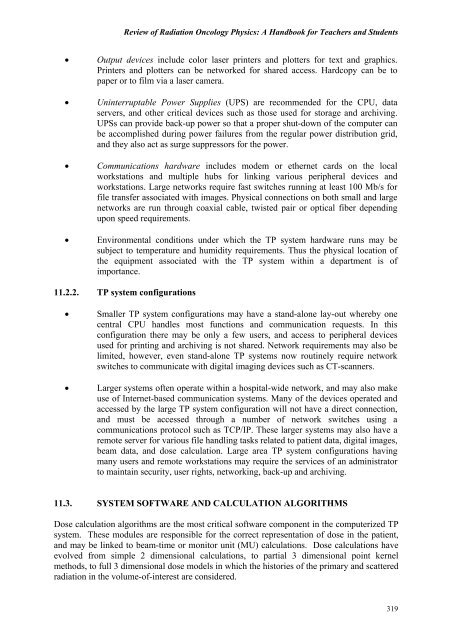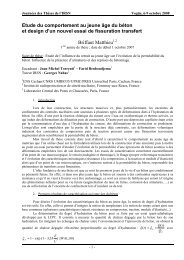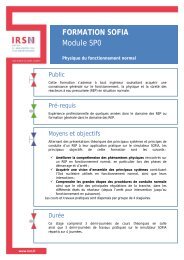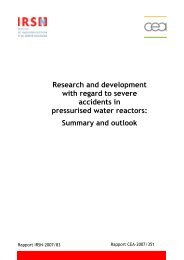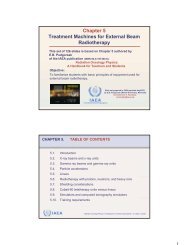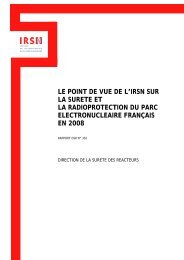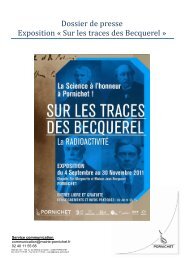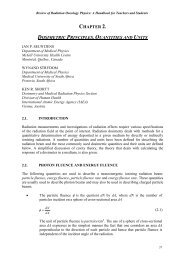Review of Radiation Therapy Physics: A syllabus for teachers ... - IRSN
Review of Radiation Therapy Physics: A syllabus for teachers ... - IRSN
Review of Radiation Therapy Physics: A syllabus for teachers ... - IRSN
Create successful ePaper yourself
Turn your PDF publications into a flip-book with our unique Google optimized e-Paper software.
<strong>Review</strong> <strong>of</strong> <strong>Radiation</strong> Oncology <strong>Physics</strong>: A Handbook <strong>for</strong> Teachers and Students• Output devices include color laser printers and plotters <strong>for</strong> text and graphics.Printers and plotters can be networked <strong>for</strong> shared access. Hardcopy can be topaper or to film via a laser camera.• Uninterruptable Power Supplies (UPS) are recommended <strong>for</strong> the CPU, dataservers, and other critical devices such as those used <strong>for</strong> storage and archiving.UPSs can provide back-up power so that a proper shut-down <strong>of</strong> the computer canbe accomplished during power failures from the regular power distribution grid,and they also act as surge suppressors <strong>for</strong> the power.• Communications hardware includes modem or ethernet cards on the localworkstations and multiple hubs <strong>for</strong> linking various peripheral devices andworkstations. Large networks require fast switches running at least 100 Mb/s <strong>for</strong>file transfer associated with images. Physical connections on both small and largenetworks are run through coaxial cable, twisted pair or optical fiber dependingupon speed requirements.• Environmental conditions under which the TP system hardware runs may besubject to temperature and humidity requirements. Thus the physical location <strong>of</strong>the equipment associated with the TP system within a department is <strong>of</strong>importance.11.2.2. TP system configurations• Smaller TP system configurations may have a stand-alone lay-out whereby onecentral CPU handles most functions and communication requests. In thisconfiguration there may be only a few users, and access to peripheral devicesused <strong>for</strong> printing and archiving is not shared. Network requirements may also belimited, however, even stand-alone TP systems now routinely require networkswitches to communicate with digital imaging devices such as CT-scanners.• Larger systems <strong>of</strong>ten operate within a hospital-wide network, and may also makeuse <strong>of</strong> Internet-based communication systems. Many <strong>of</strong> the devices operated andaccessed by the large TP system configuration will not have a direct connection,and must be accessed through a number <strong>of</strong> network switches using acommunications protocol such as TCP/IP. These larger systems may also have aremote server <strong>for</strong> various file handling tasks related to patient data, digital images,beam data, and dose calculation. Large area TP system configurations havingmany users and remote workstations may require the services <strong>of</strong> an administratorto maintain security, user rights, networking, back-up and archiving.11.3. SYSTEM SOFTWARE AND CALCULATION ALGORITHMSDose calculation algorithms are the most critical s<strong>of</strong>tware component in the computerized TPsystem. These modules are responsible <strong>for</strong> the correct representation <strong>of</strong> dose in the patient,and may be linked to beam-time or monitor unit (MU) calculations. Dose calculations haveevolved from simple 2 dimensional calculations, to partial 3 dimensional point kernelmethods, to full 3 dimensional dose models in which the histories <strong>of</strong> the primary and scatteredradiation in the volume-<strong>of</strong>-interest are considered.319


